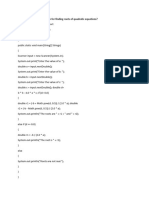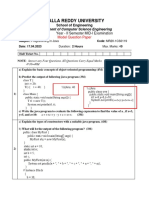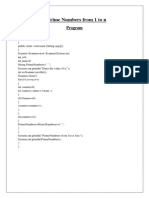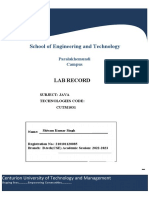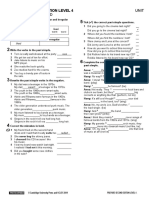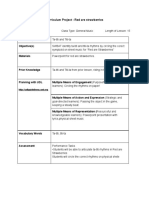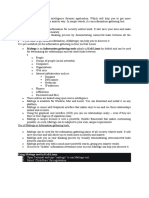1.
Write a program declaring a class Rectangle with data member’s length and breadth and
member functions Input, Output and CalcArea.
import java.util.Scanner;
class Rectangle {
float length;
float breadth;
public void Input() {
Scanner scanner = new Scanner(System.in);
System.out.print("Enter length: ");
length = scanner.nextFloat();
System.out.print("Enter breadth: ");
breadth = scanner.nextFloat();
}
public void Output() {
System.out.println("Length: " + length);
System.out.println("Breadth: " + breadth);
}
public float CalcArea() {
return length * breadth;
}
public static void main(String[] args) {
Rectangle rect = new Rectangle();
rect.Input();
rect.Output();
System.out.println("Area of Rectangle: " + rect.CalcArea());
}
}
OUTPUT:
1
�2. Write a program to demonstrate use of method overloading to calculate area of square,
rectangle and triangle.
import java.util.Scanner;
class AreaCalculator {
public float CalcArea(float side) {
return side * side;
}
public float CalcArea(float length, float breadth) {
return length * breadth;
}
public float CalcArea(float base, float height, boolean isTriangle) {
if (isTriangle) {
return 0.5f * base * height;
}
return 0;
}
public static void main(String[] args) {
Scanner scanner = new Scanner(System.in);
AreaCalculator calc = new AreaCalculator();
System.out.print("Enter side of square: ");
float side = scanner.nextFloat();
System.out.println("Area of Square: " + calc.CalcArea(side));
System.out.print("Enter length of rectangle: ");
float length = scanner.nextFloat();
System.out.print("Enter breadth of rectangle: ");
float breadth = scanner.nextFloat();
System.out.println("Area of Rectangle: " + calc.CalcArea(length, breadth));
System.out.print("Enter base of triangle: ");
float base = scanner.nextFloat();
System.out.print("Enter height of triangle: ");
float height = scanner.nextFloat();
System.out.println("Area of Triangle: " + calc.CalcArea(base, height, true));
}
}
2
�OUTPUT:
3
�3. Write a program to demonstrate the use of static variable, static method and static block
import java.util.Scanner;
class StaticDemo {
static int count;
static
{
count = 0;
}
public StaticDemo() {
count++;
}
public static void displayCount() {
System.out.println("Number of objects : " + count);
}
public static void main(String[] args) {
Scanner scanner = new Scanner(System.in);
StaticDemo obj1 = new StaticDemo();
StaticDemo obj2 = new StaticDemo();
StaticDemo obj3 = new StaticDemo();
StaticDemo.displayCount();
}
}
OUTPUT:
4
�4. Write a program to demonstrate concept of ``this``.
class Const
{
int a,b;
@Override
public String toString()
{
return this.a + "+" + this.b;
}
Const(int a,int b)
{
this.a=a;
this.b=b;
}
Const(int a)
{
this(a,a);
}
Const()
{
this(0);
}
};
class Main
{
public static void main(String[] args)
{
Const one=new Const(10,13);
Const two=new Const(20);
Const three=new Const();
System.out.println(one);
System.out.println(two);
System.out.println(three);
}
}
OUTPUT:
5
�5. Write a program to demonstrate multi-level and hierarchical inheritance
//Multi-level
class Animal {
void speak()
{
System.out.println("this is animal");
}
}
class Dog extends Animal {
void speak()
{
super.speak();
System.out.println("Dog barks");
}
}
class Husky extends Dog {
void speak()
{
super.speak();
System.out.println("Husky is trained");
}
}
public class Main {
public static void main(String[] args) {
Husky one = new Husky();
one.speak();
}
}
OUTPUT:
6
�//Hierarchical
class Animal {
void speak()
{
System.out.println("Animal makes a sound");
}
}
class Dog extends Animal {
void speak()
{
System.out.println("Dog barks");
}
}
class Cat extends Animal {
void speak()
{
System.out.println("cat meows");
}
}
public class Main {
public static void main(String[] args) {
Animal dog = new Dog();
Animal cat = new Cat();
dog.speak();
cat.speak();
}
}
OUTPUT:
7
�6. Write a program to use super() to invoke base class constructor.
class Animal {
void speak()
{
System.out.println("Animal makes a sound");
}
}
class Dog extends Animal {
@Override
void speak() {
// Using super() to call the speak method of the parent class
super.speak(); // Calls Animal's speak method
System.out.println("Dog barks");
}
}
public class Main {
public static void main(String[] args) {
Dog dog = new Dog();
dog.speak();
}
}
OUTPUT:
8
�7. Write a program to demonstrate run-time polymorphism.
class Animal {
void speak()
{
System.out.println("Animal makes a sound");
}
}
class Dog extends Animal {
@Override
void speak()
{
System.out.println("Dog barks");
}
}
public class Main {
public static void main(String[] args) {
Dog dog = new Dog();
dog.speak();
}
}
OUTPUT:
9
�8. Write a program to demonstrate the concept of aggregation.
import java.util.Scanner;
class Address {
String city;
String state;
String country;
Address(String city, String state, String country) {
this.city = city;
this.state = state;
this.country = country;
}
}
class Employee {
int id;
String name;
Address address;
Employee(int id, String name, Address address) {
this.id = id;
this.name = name;
this.address = address;
}
public void display() {
System.out.println("ID: " + id);
System.out.println("Name: " + name);
System.out.println("Address: " + address.city + ", " + address.state + ", " + address.country);
}
}
class AggregationDemo {
public static void main(String[] args) {
Address address1 = new Address("New York", "NY", "USA");
Address address2 = new Address("Los Angeles", "CA", "USA");
Employee emp1 = new Employee(101, "John Doe", address1);
Employee emp2 = new Employee(102, "Jane Smith", address2);
emp1.display();
emp2.display();
}
}
10
�OUTPUT:
11
�9. Write a program to demonstrate the concept of abstract class with constructor and ``final``
method.
abstract class Shape
{
String name;
Shape(String name)
{
this.name = name;
}
abstract void draw();
final void display() {
System.out.println("This is a shape: " + name);
}
}
class Circle extends Shape {
Circle() {
super("Circle");
}
@Override
void draw() {
System.out.println("Drawing a Circle");
}
}
public class AbstractDemo {
public static void main(String[] args) {
Circle circle = new Circle();
circle.draw();
circle.display();
}
}
OUTPUT:
12
�10. Write a program to demonstrate the concept of interface when two interfaces have unique
methods and same data members
abstract class Shape
{
String name;
Shape(String name)
{
this.name = name;
}
abstract void draw();
final void display() {
System.out.println("Shape is : " + name);
}
}
class Circle extends Shape {
Circle() {
super("Circle");
}
@Override
void draw() {
System.out.println("Drawing a Circle");
}
}
public class AbstractDemo {
public static void main(String[] args) {
Circle circle = new Circle();
circle.draw();
circle.display();
}
}
OUTPUT:
13





